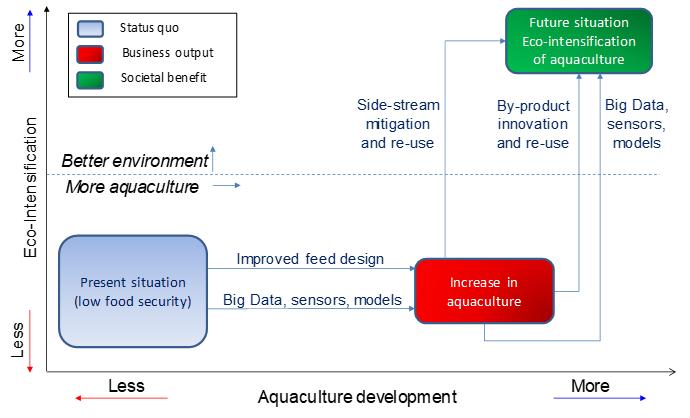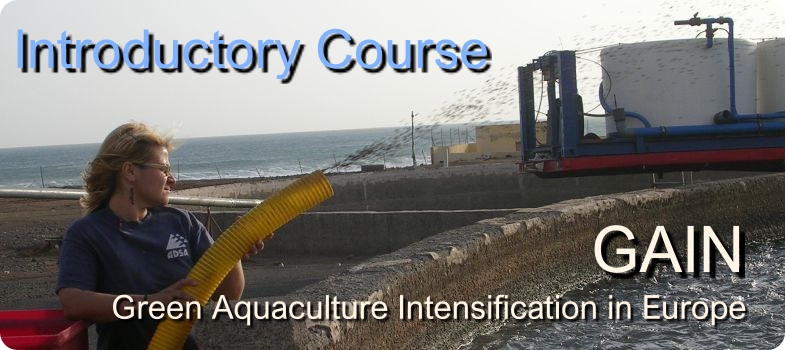How does GAIN intend to address the challenges of that paradigm shift?
Introduction to the objectives of the GAIN project
Presentation
The general GAIN approach is a path towards ecological intensification that requires both greater skills from managers and operators, and higher capital investment in aquafarm enterprises to enhance the infrastructure for monitoring and control, and to increase the capacity of handling secondary outputs. Such a path aims at combining the development of aquaculture with a better environment.
.
Figure 1: Schematic representation of the GAIN approach
Ecological intensification of European aquaculture is a transdisciplinary challenge that requires the integration of scientific and technical innovations, new policies and economic instruments, and the mitigation and, if possible, removal of social constraints. For the GAIN project, it is then a multi-dimensional problem, containing several cross-cutting issues. These require solutions at different time and space scales, and can be categorised into three groups: (i) solutions that need core science research; (ii) solutions that are fundamentally technological, i.e. the scientific basis is well-established, but there is insufficient market proximity; and (iii) issues related to social values and acceptance, which may require some societal changes.
Intensification of aquaculture in Europe can occur through spatial expansion, addressed in other Horizon 2020 projects. There is plenty of scope for spatial development from the perspective of ecosystem quality and sustainability (e.g. Gentry et al., 2017), but the same cannot be said for social license, which is a serious obstacle to growth. Furthermore, spatial expansion does not necessarily equate with ecological intensification, and the environmental consequences of using larger areas for aquaculture are often the object of substantial controversy, which in turn conditions licensing. This makes the concept of ecological intensification, using the space already available, a particularly promising avenue for development.
GAIN focuses on better use of existing resources, which can help the aquaculture sector grow significantly. Three areas are key to this growth:
1. Improvement in the capacity to feed farmed species without increasing the pressure on land, fish stocks, and respecting both animal welfare and the environment;
2. Better use of side-streams, which will potentially allow increases in stocking density by reducing the environmental footprint of cultivation;
3. Value-adding through innovative re-use, i.e. leveraging the potential for food and other uses of cultivation by-products.
Allied to these areas, better acquisition and delivery of environmental information to producers will promote precision aquaculture, which will significantly improve growth performance, animal welfare, and optimise available space.
GAIN focuses on the most important species and aquaculture types in Europe, but also considers high-value niche products which are important in specific regions, as well as emerging aquaculture products. The fish species studied within the project are:
- Atlantic salmon
- Rainbow trout
- Sea bass
- Gilthead bream
- Common Carp
- Turbot
And the shellfish species are:
- Oysters
- Mussels
- Clams
In order to ensure the success of the project in enhancing the implementation of ecological intensification in aquaculture, GAIN partners organised their activity around four main pillars, each covered in a dedicated open course:
- Sustainability of aquaculture products
- Sustainable aquafeeds
- Precision aquaculture
- Valorisation of aquaculture wastes: An approach to the circular economy
